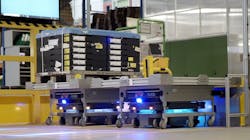5 Steps for Successful Autonomous Mobile Robot Deployment
When Valeo, a global manufacturer of automotive parts, was looking to increase the efficiency of its internal transportation process—and challenges connected to the labor market—in its Poland-based wiper plant, it discovered the value of autonomous mobile robots (AMRs).
AMRs allow companies to quickly, easily and cost-effectively manage internal logistics while freeing up employees to perform higher-value tasks. This is especially relevant as ongoing labor shortages across myriad industries and disrupted supply chains make dull, dirty, repetitive and dangerous tasks difficult to fill.
Since implementing AMRs, Valeo reports it has improved safety, eliminated damage within the facility and reduced time to market. The mobile robots transport containers with small parts on specially designed carts with racks, towing them via an attached hook. Automating intralogistics “has significantly improved the efficiency of our processes,” says Dominik Wasiel, Valeo’s site supply chain manager.
READ MORE: Swarm Robotics: Taking a Cue from Bees and Birds
Managing AMR Implementation
Early adopters of AMRs know their value and are increasingly expanding their fleets. Those still holding off may recognize that AMRs can solve their challenges but might feel overwhelmed about how to get started. No company needs to do it alone, however.
For Valeo’s AMR implementation, the manufacturer teamed with MiR distributor ASTOR, which developed the project conceptually, and partner GM Automatyka, which handled the implementation of the project in terms of mechanics, electrics and applications.
When ready to get started with AMRs, consider these five steps to successfully manage a deployment project:
1. Application Review
With an idea of which applications to automate, sit down with the vendor, distributor or certified system integrator (CSI)—or all three—to discuss and confirm that what can be done is critical. Once initial applications for the AMR are discussed and outlined, these will likely be sent to the vendor’s application development team for review.
During this stage, the development team can be expected to make recommendations on best practices to optimize the outcome of the project, which might include cutting out aspects of the project that won’t work or don’t support the intended goals. This ensures that the scope of any project remains on target and reduces wasted resources. The results of this process are then consolidated into a design report that can go on for review between the CSI partner (or partners) and the customer.
A design review form should include the pace of the deployment process and the layout of the facility, including routes the robots can travel on the floor, with tracks where they could interact with other robots or other human workers. Keeping track of the customer’s inventory within the facility—such as other pre-existing robots, conveyors, forklifts, Wi-Fi, ERP, warehouse management software (WMS) and manufacturing execution systems (MES)—is also important. The vendor will then evaluate that information against the specs of the robots they offer and any top modules appropriate for the application to find the right solution for the customer.
At this stage of the process, work with the vendor, distributor or CSI to establish ideal routes for the robots. For example, if the robot needs two meters of space for driving, and the customer only has 1.5 meters, they will suggest looking for other ways to get the route completed—such as alternative paths or limiting the aisle way to one-way traffic instead of bi-directional. They will also evaluate network infrastructure, operating environment and other non-AMR traffic to determine how the robots can work around those devices.
In Valeo’s case, the challenge was the diversity of pallet types used. “Every customer has their own specific pallet,” Wasiel says. “We’re a manufacturer that must adapt to customers, and that means each line has a different way of discharging goods. On top of that, there are different operational corridor widths inside the plant.” The implementation partners helped Valeo determine the best routes for the robots.
READ MORE: Getting your Head Around Adding AMRs into Operations
2. Kick-Off Meeting
After the review phase is complete and suggested adjustments have been agreed upon, it is time for the team to meet with the CSI partners to discuss the design review. A project manager from the CSI, as well as an application engineer from the vendor, will likely review the project requirements for deployment and address any other technical questions. They will also establish the schedule for key milestones of the deployment project and make sure everything is in place to meet the deadlines, including access to support resources.
3. Project Meetings
Good communication is key to implementing complex deployment plans. Meet regularly to discuss progress to ensure it stays on schedule and follow up with any adjustments. This helps maintain alignment across the project team. Meetings can be held remotely for convenience, if necessary.
READ MORE: Autonomous Mobile Robots and Cobots Improve Worker Safety and Retention
4. Actual Implementation
Even when recruiting the advice of outside counsel, it is typical for the CSI (and partners, in Valeo’s case) to be responsible for the actual implementation phase. As a result, expect to establish milestones with partners and encourage them to keep to the schedule. Many customers choose to take advantage of downtimes or slow seasons to implement new infrastructure, but this creates more of a demand on partners and should be planned.
On some of the more complex projects that involve multiple robots across multiple facilities, the partner’s deployment team will expand to help meet these needs. These teams provide essential support to navigate the adoption of new technology and help to align internal stakeholders such as IT or operations.
5. Service and Support
Once the deployment is complete and signed off, the final phase is to transition to long-term support. Planning for future maintenance will help prevent unnecessary downtime. Given the cost of the initial implementation, it makes sense to finance a strong customer support system with expertise in AMRs to protect the initial investment.


